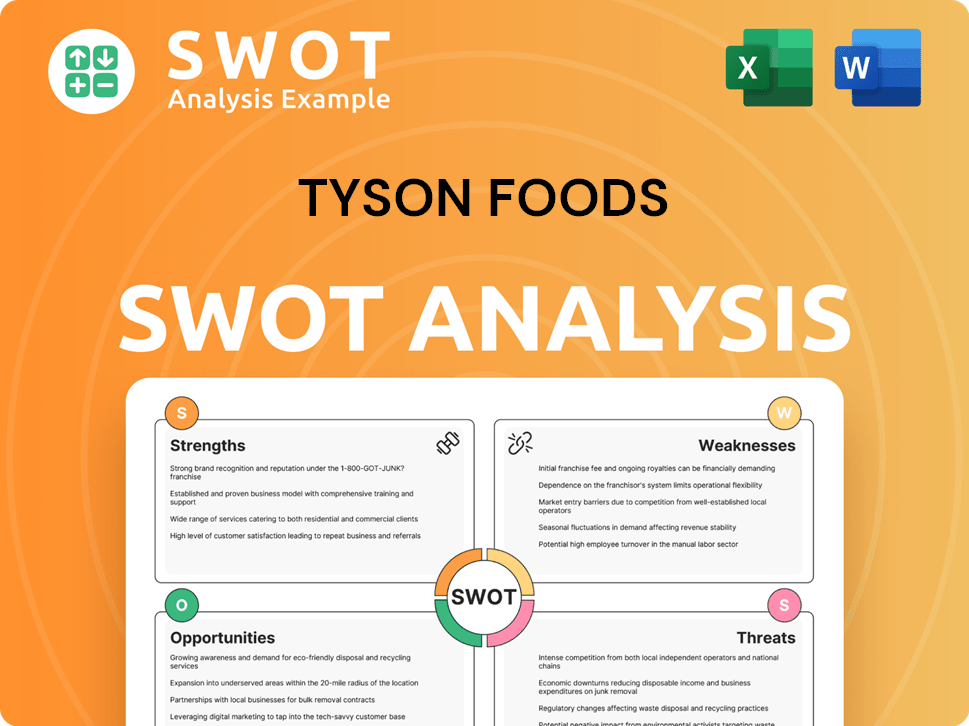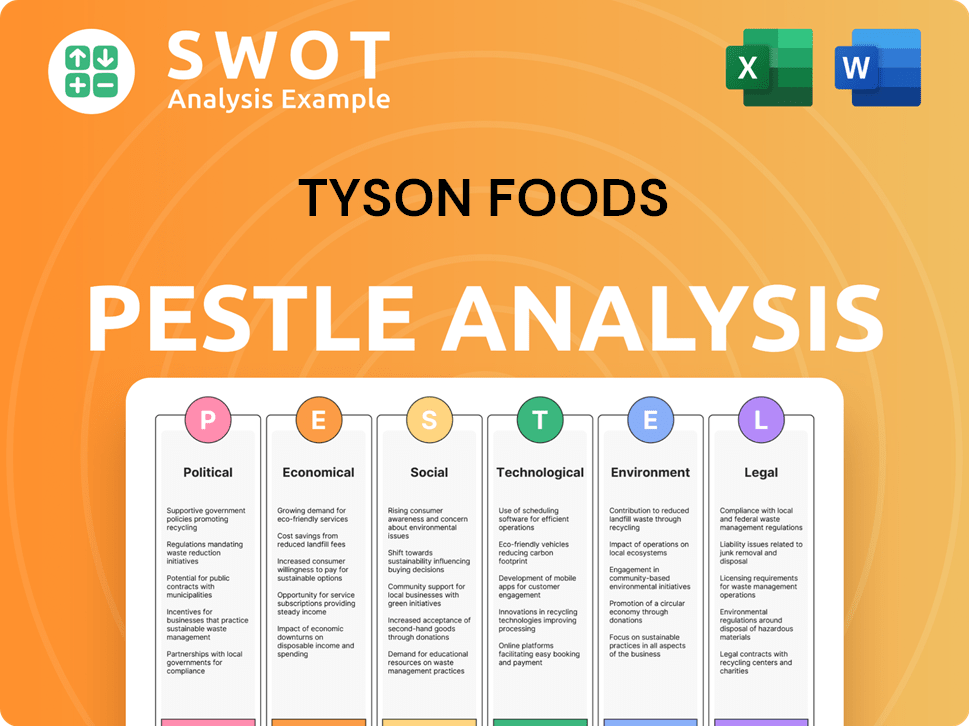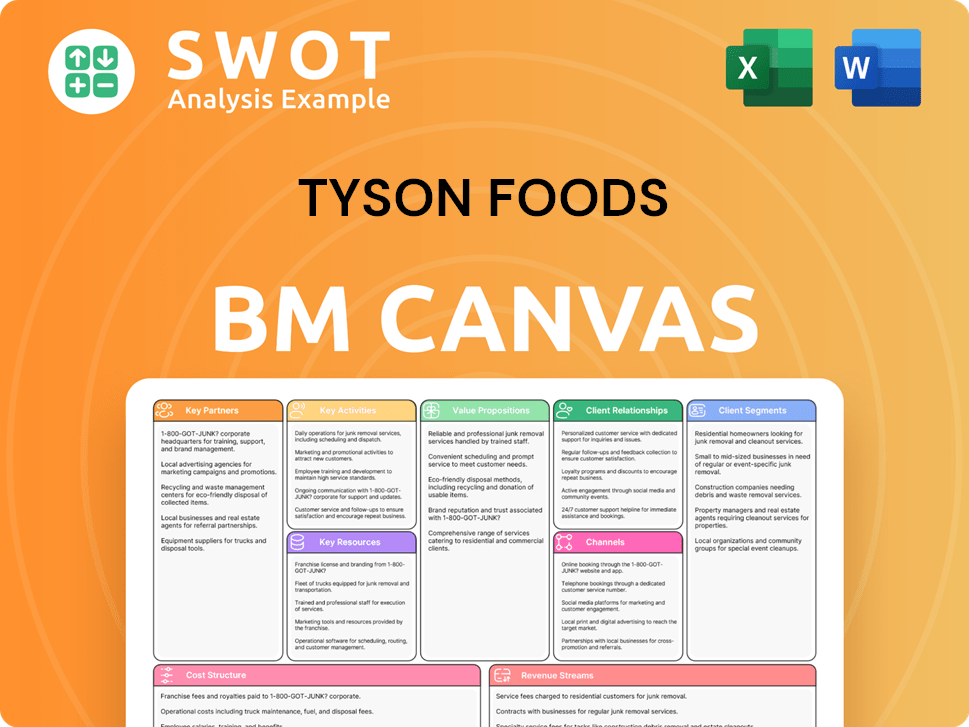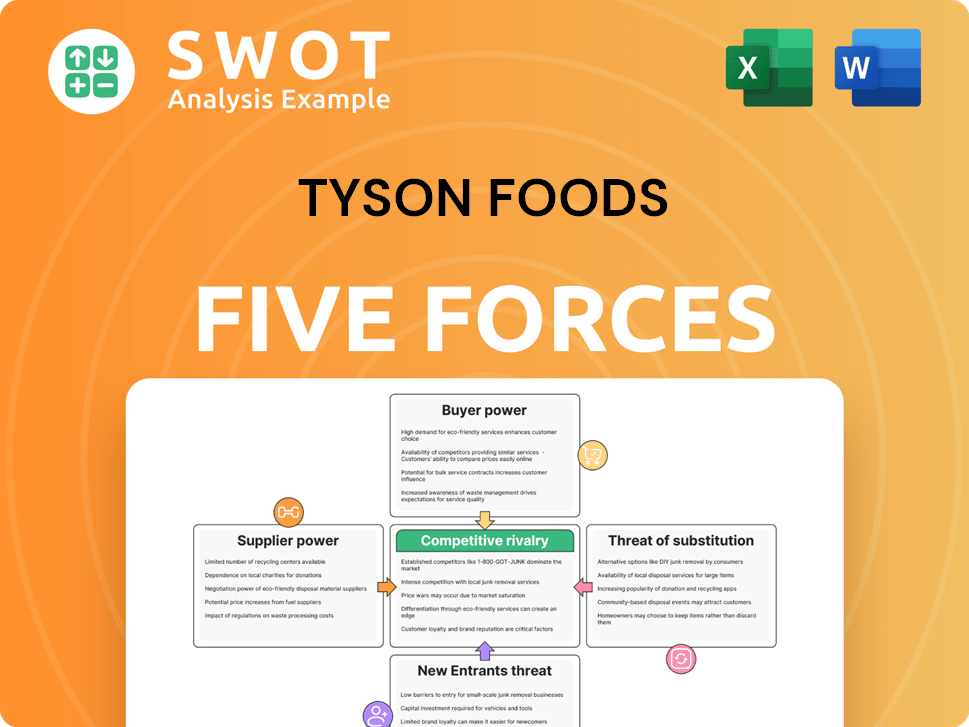Tyson Foods Bundle
Who Buys Tyson Foods?
In the ever-changing food industry, understanding customer demographics and the target market is crucial for companies like Tyson Foods. With consumer preferences constantly evolving, especially regarding health and sustainability, how does Tyson Foods adapt? This exploration delves into the Tyson Foods SWOT Analysis, examining the company's approach to its customer base and market positioning.

Tyson Foods, a global leader in protein, has a diverse customer base, and a deep dive into its customer demographics reveals valuable insights. This analysis will uncover who the typical Tyson Foods consumer is, exploring their purchasing habits, and how the company tailors its strategies. We'll look at the target market geographic location, and consumer preferences for Tyson Foods products.
Who Are Tyson Foods’s Main Customers?
Understanding the customer demographics of Tyson Foods is crucial for grasping its market position. The company serves a broad customer base, spanning both consumers (B2C) and businesses (B2B). This diverse approach allows it to capture a significant share of the food market, catering to various needs and preferences across different segments.
The company's target market strategy focuses on providing high-quality protein products at competitive prices, which appeals to families, individuals, and foodservice businesses. Nearly 75% of U.S. households purchased a product in the past year, indicating a wide consumer reach. This widespread appeal is a testament to its ability to meet the diverse needs of its customer base.
The company's customer base includes a wide range of consumers. Its products are designed to appeal to all age groups, from young children who enjoy chicken nuggets to older adults who prefer premium cuts of beef and pork. This broad appeal is a key factor in the company's success in the market.
The B2C segment includes individual consumers and families. These customers purchase products from retail outlets such as supermarkets and grocery stores. The company's product range includes various items like chicken, beef, pork, and prepared foods, catering to different tastes and dietary preferences. The company's focus on providing high-quality protein products at competitive prices makes it a popular choice for consumers.
The B2B segment includes food retailers, foodservice distributors, restaurant operators, and other businesses. These customers purchase products in bulk for resale or use in their operations. This segment is critical for the company's revenue, with sales to foodservice channels contributing significantly to overall sales. The company's ability to supply high-quality products to these businesses is a key competitive advantage.
The company segments its business into Chicken, Beef, Pork, and Prepared Foods. As of the second quarter of fiscal year 2025, the Beef and Chicken segments each contribute approximately one-third of U.S. sales. The Prepared Foods segment accounts for a significant portion of sales, with the chicken segment showing robust performance. The company's diverse product portfolio allows it to cater to a wide range of customer preferences and market demands.
The company's products are sold across various geographic locations. It has a strong presence in the United States, with a significant portion of its sales coming from this market. The company also has operations and sales in international markets, expanding its customer base globally. The company's widespread distribution network ensures that its products are accessible to consumers and businesses in numerous regions.
The company continually adapts to changing consumer preferences and market trends. One notable trend is the increasing demand for healthier and more sustainable food options, which has led the company to expand its portfolio of organic, natural, and plant-based products. Another key trend is the consumer's focus on value, which influences purchasing decisions across different protein categories.
- The company is expanding its portfolio of organic, natural, and plant-based products.
- Consumers are increasingly seeking value, which influences their purchasing decisions.
- The company is investing in value-added chicken products to meet growing demand.
- The company's multi-protein portfolio allows shoppers to trade from higher-priced meats to more affordable options.
Tyson Foods SWOT Analysis
- Complete SWOT Breakdown
- Fully Customizable
- Editable in Excel & Word
- Professional Formatting
- Investor-Ready Format

What Do Tyson Foods’s Customers Want?
Understanding the customer needs and preferences is crucial for the success of any food company, and for Tyson Foods, this means focusing on high-quality protein, convenience, and value. The company's strategies are heavily influenced by consumer demand for protein, as well as the need for easy-to-prepare meals. This approach allows the company to tailor its product offerings and marketing efforts to meet the evolving demands of its diverse customer base.
The primary drivers for the company's product development are the consumers' desire for more protein and convenient food options. Consumers are increasingly health-conscious and looking for ways to incorporate more protein into their diets. The company also recognizes the importance of convenience, offering products that save time without sacrificing taste or freshness. This customer-centric approach helps the company stay relevant and competitive in a dynamic market.
The company's focus on customer needs and preferences is reflected in its product innovations and marketing strategies. By understanding the key factors that influence consumer purchasing decisions, such as affordability and brand loyalty, the company can effectively target its audience and maintain a strong market position. This proactive approach enables the company to adapt to changing consumer behaviors and preferences, ensuring its continued success.
Consumers are actively seeking to increase their protein consumption. A 2024 International Food Information Council study indicated that 71% of U.S. consumers aimed to increase their protein intake.
Purchasing behaviors show a strong inclination towards convenience. Time-strapped consumers are seeking products that save preparation time without sacrificing flavor or freshness.
Decision-making criteria often include affordability. Inflation has pushed consumers to be more price-sensitive and prioritize essential staples.
Loyalty factors are built on trust in the brand and consistent delivery of quality products. Consistent quality and brand trust are key to retaining customers.
Consumers are increasingly seeking healthier options. The company's product launches, such as Fully Cooked Flamebroiled Turkey Patties, directly respond to these needs.
The company actively uses consumer data and trends to tailor its products and marketing strategies. They leverage proprietary AI technology to understand digital consumer preferences.
The company's focus on customer needs is evident in its new product launches and marketing strategies. The company actively uses consumer data and trends to tailor its products. Here are some key insights:
- Convenience: The demand for pre-seasoned meat cuts, meal packs, and ready-to-eat and frozen food options is increasing.
- Health: A 2024 study revealed that 62% of consumers are eating turkey more often for health reasons.
- Premium Perception: 54% of consumers perceive turkey as a premium protein option.
- Product Examples: The company launched products like Tyson Honey Stung Chicken Chunks and Fully Cooked Flamebroiled Turkey Patties to meet consumer needs.
Tyson Foods PESTLE Analysis
- Covers All 6 PESTLE Categories
- No Research Needed – Save Hours of Work
- Built by Experts, Trusted by Consultants
- Instant Download, Ready to Use
- 100% Editable, Fully Customizable

Where does Tyson Foods operate?
Tyson Foods maintains a significant geographical market presence, with operations spanning across the United States and reaching customers in over 80 countries globally. The company's headquarters are located in Springdale, Arkansas, and it operates more than 300 production facilities and sales offices within the U.S.
In fiscal year 2024, Tyson Foods sold its products to customers in approximately 140 countries, demonstrating a broad international reach. Key markets include Australia, Canada, Central America, Chile, China, the European Union, the United Kingdom, Japan, Mexico, Malaysia, the Middle East, Singapore, South Korea, Taiwan, and Thailand. This extensive global presence is a key aspect of its overall strategy.
The company's international sales represented a modest 4% of total revenue in fiscal 2024, indicating that while the U.S. remains its primary market, international expansion is a strategic opportunity for growth. Tyson Foods is actively working to increase its global footprint.
Tyson Foods has a strong presence in the United States, with over 300 production facilities and sales offices. The company's products are available in various retail and foodservice channels across the country.
The company sells its products in approximately 140 countries. Key international markets include Canada, Mexico, China, and several countries in Europe and Asia. International sales accounted for 4% of total revenue in fiscal 2024.
Tyson Foods has made strategic acquisitions to expand its international presence. The acquisition of the Thai and European operations of BRF SA in 2019 is a notable example. These acquisitions help to extend its value-added protein offerings globally.
Tyson Foods plans to continue growing its international business by expanding its footprint in high-demand markets. Investments in expanded capacity in Asia are underway. The company anticipates improved results from its foreign operations in fiscal 2025.
Tyson Foods Business Model Canvas
- Complete 9-Block Business Model Canvas
- Effortlessly Communicate Your Business Strategy
- Investor-Ready BMC Format
- 100% Editable and Customizable
- Clear and Structured Layout

How Does Tyson Foods Win & Keep Customers?
Tyson Foods' approach to customer acquisition and retention is multifaceted, focusing on a diverse range of marketing channels and product innovation to meet the evolving needs of its consumer base. The company's strategy is built around a multi-protein portfolio, enabling it to cater to varied consumer preferences for high-quality protein products. This approach is supported by significant investments in advertising and promotional activities, aimed at strengthening market presence and driving sales.
The company employs a mix of traditional and digital marketing techniques to reach its target market. This includes television advertising, digital marketing campaigns, print media, and outdoor advertising. In fiscal year 2023, Tyson Foods allocated $291.1 million for advertising expenses, with approximately $300 million planned for 2024 to support sales. Digital transformation plays a crucial role, with efforts to enhance how consumers discover products, including the use of generative AI for improved browsing and search experiences, especially in the foodservice sector.
Customer retention is further supported by ongoing investments in product innovation, introducing new flavors, packaging designs, and product lines to keep offerings fresh and appealing. The company emphasizes customer engagement by actively listening to feedback and responding to needs, aiming to build strong relationships. This focus on adaptability, operational excellence, and continuous innovation contributes to customer loyalty and long-term value. Understanding the Owners & Shareholders of Tyson Foods can provide additional insights into the company's strategic direction and financial performance.
Tyson Foods utilizes a diverse array of marketing channels to reach its target audience. These include television advertising, digital marketing, print media, and outdoor advertising. The allocation of marketing spend across different channels is strategic, aiming to maximize reach and impact.
The company invests heavily in advertising to strengthen its market presence. In fiscal year 2023, Tyson Foods spent $291.1 million on advertising. The company plans to spend around $300 million in 2024 to support sales and marketing initiatives.
Digital transformation is a key enabler for Tyson Foods, enhancing how consumers and customers discover its products. This includes leveraging generative AI to improve browsing and search experiences, especially in the foodservice channel. These efforts aim to provide a more intuitive and user-friendly experience.
Sales tactics involve segmenting marketing spend across product categories. For example, 45% of the promotional budget is for chicken products, 30% for prepared foods, and 25% for beef and pork, reflecting targeted advertising. This strategy ensures that marketing efforts align with specific product lines and consumer segments.
Tyson Foods continuously invests in product innovation to meet evolving consumer demands. New products include Hillshire Snacking Dips and Spreads, Tyson Honey Stung Chicken Chunks, and Wright Brand Premium Smoked Sausage Links. These innovations focus on convenience, taste, and quality.
The company emphasizes customer engagement by actively listening to feedback and responding to needs. This approach aims to build strong relationships with consumers. This direct interaction helps in understanding and adapting to changing consumer preferences.
Tyson Foods' 'multi-protein, multi-channel strategy' has proven effective. This strategy allows the company to meet diverse consumer demands and adapt to market dynamics. This approach is particularly relevant in an environment where consumers are seeking value.
The company adapts to changing consumer preferences and market dynamics. This adaptability is crucial for maintaining customer loyalty and long-term value. This includes responding to trends such as the search for value and trading down to lower-priced meats.
Tyson Foods focuses on operational excellence and customer satisfaction. This focus contributes to customer loyalty and long-term value. Continuous innovation and improvements in operational efficiency are key drivers of success.
Tyson Foods sponsors sports leagues and culinary events to enhance brand visibility. This strategy increases brand awareness and engagement with consumers. These sponsorships help in reaching a wider audience and building brand recognition.
Tyson Foods Porter's Five Forces Analysis
- Covers All 5 Competitive Forces in Detail
- Structured for Consultants, Students, and Founders
- 100% Editable in Microsoft Word & Excel
- Instant Digital Download – Use Immediately
- Compatible with Mac & PC – Fully Unlocked

Related Blogs
- What are Mission Vision & Core Values of Tyson Foods Company?
- What is Competitive Landscape of Tyson Foods Company?
- What is Growth Strategy and Future Prospects of Tyson Foods Company?
- How Does Tyson Foods Company Work?
- What is Sales and Marketing Strategy of Tyson Foods Company?
- What is Brief History of Tyson Foods Company?
- Who Owns Tyson Foods Company?
Disclaimer
All information, articles, and product details provided on this website are for general informational and educational purposes only. We do not claim any ownership over, nor do we intend to infringe upon, any trademarks, copyrights, logos, brand names, or other intellectual property mentioned or depicted on this site. Such intellectual property remains the property of its respective owners, and any references here are made solely for identification or informational purposes, without implying any affiliation, endorsement, or partnership.
We make no representations or warranties, express or implied, regarding the accuracy, completeness, or suitability of any content or products presented. Nothing on this website should be construed as legal, tax, investment, financial, medical, or other professional advice. In addition, no part of this site—including articles or product references—constitutes a solicitation, recommendation, endorsement, advertisement, or offer to buy or sell any securities, franchises, or other financial instruments, particularly in jurisdictions where such activity would be unlawful.
All content is of a general nature and may not address the specific circumstances of any individual or entity. It is not a substitute for professional advice or services. Any actions you take based on the information provided here are strictly at your own risk. You accept full responsibility for any decisions or outcomes arising from your use of this website and agree to release us from any liability in connection with your use of, or reliance upon, the content or products found herein.